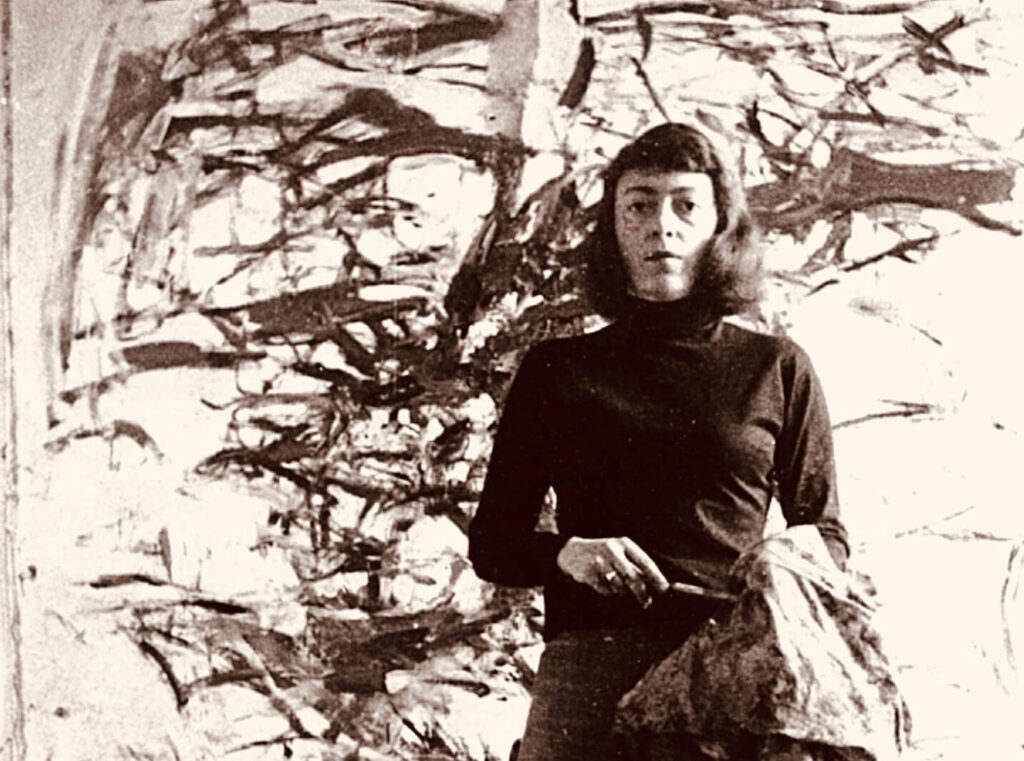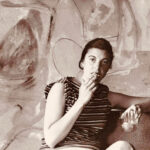Joan Mitchell
Joan Mitchell (1925-1992) was an influential American abstract expressionist painter whose vibrant, dynamic works left an indelible mark on the art world. Known for her emotive use of color and expressive brushstrokes, Mitchell’s paintings capture the beauty and chaos of nature, reflecting her deep connection to the natural world. This biography explores Mitchell’s life, career, and three of her most important artworks, highlighting her significant contributions to modern art.

Early Life and Education
Joan Mitchell was born on February 12, 1925, in Chicago, Illinois, into a wealthy and cultured family. Her father, James Herbert Mitchell, was a dermatologist, and her mother, Marion Strobel Mitchell, was a poet and editor at Poetry magazine. Growing up in a creative environment, Mitchell was exposed to literature and the arts from an early age, fostering her interest in painting and writing.
Mitchell attended the progressive Francis W. Parker School in Chicago, where she excelled in both academics and athletics. She went on to study at Smith College in Northampton, Massachusetts, before transferring to the School of the Art Institute of Chicago (SAIC). At SAIC, Mitchell studied under painter Paul Wieghardt and developed her skills in drawing and painting. She graduated with a Bachelor of Fine Arts degree in 1947.
After graduation, Mitchell received a fellowship to study in Europe, where she was exposed to the works of the European avant-garde. Her travels to France and Spain significantly influenced her artistic development, introducing her to the works of artists like Vincent van Gogh, Claude Monet, and Henri Matisse.
Early Career and Artistic Development
Upon her return to the United States in 1949, Mitchell moved to New York City, where she became part of the burgeoning abstract expressionist movement. She quickly immersed herself in the vibrant art scene, forming friendships with fellow artists such as Willem de Kooning, Franz Kline, and Jackson Pollock. These relationships, along with her exposure to the work of abstract expressionists, profoundly impacted her developing style.
Mitchell’s early works were characterized by their bold, gestural brushstrokes and intense use of color. She drew inspiration from the natural world, particularly the landscapes and seascapes of her childhood. Her paintings often featured dynamic compositions that conveyed a sense of movement and energy, reflecting her emotional response to the environment.
In the early 1950s, Mitchell’s work began to gain recognition. She participated in several group exhibitions, including the landmark “Ninth Street Show” in 1951, which showcased the works of prominent abstract expressionists. Her first solo exhibition took place in 1952 at the New Gallery in New York City, solidifying her position within the art world.
Transition to France and Mature Style
In 1955, Mitchell received a fellowship from the Ford Foundation that allowed her to return to Europe. She settled in Paris, where she became part of the expatriate artist community. In 1959, she purchased a house in Vétheuil, a small village on the Seine River, where she would spend much of her later life.
The move to France marked a significant transition in Mitchell’s work. Her paintings from this period became more expansive and complex, with an increased emphasis on color and light. She drew inspiration from the French countryside, particularly the landscapes around Vétheuil, which had been the home of Claude Monet.
Important Artworks
Three of Mitchell’s most important artworks are “Hemlock” (1956), “No Birds” (1987-88), and “Sunflower VI” (1969), which exemplify her mastery of color, composition, and emotional depth.
“Hemlock” (1956)
“Hemlock” is one of Mitchell’s early masterpieces, showcasing her bold use of color and gestural brushwork. The painting features a dynamic composition of swirling, overlapping forms in shades of green, blue, and black. The dense network of brushstrokes creates a sense of depth and movement, evoking the tangled branches of a hemlock tree.
The title “Hemlock” suggests a connection to nature, reflecting Mitchell’s fascination with the natural world. The painting’s intense energy and vibrant colors convey a sense of both chaos and harmony, capturing the beauty and complexity of the environment. “Hemlock” exemplifies Mitchell’s ability to translate her emotional response to nature into abstract forms, creating a powerful visual experience.
“No Birds” (1987-88)
“No Birds” is one of Mitchell’s later works, created during a period of personal reflection and introspection. The painting features a large, horizontal composition with bold, gestural brushstrokes in shades of blue, green, yellow, and white. The colors seem to explode across the canvas, creating a sense of movement and energy.
The title “No Birds” suggests a sense of absence or loss, perhaps reflecting Mitchell’s feelings of isolation and longing. The painting’s vibrant colors and dynamic composition convey a sense of both vitality and melancholy, capturing the complexity of human emotions. “No Birds” is a testament to Mitchell’s ability to convey deep emotional states through her use of color and form.
“Sunflower VI” (1969)
“Sunflower VI” is part of a series of paintings inspired by the sunflower, a motif that held personal significance for Mitchell. The painting features a dense, vertical composition of overlapping brushstrokes in shades of yellow, orange, green, and blue. The vibrant colors and dynamic forms evoke the radiant energy of a sunflower in full bloom.
The sunflower series reflects Mitchell’s fascination with the cycles of life and nature. The paintings capture the beauty and vitality of the sunflower, as well as its eventual decay and transformation. “Sunflower VI” exemplifies Mitchell’s ability to convey the ephemeral qualities of nature through her use of color and form, creating a powerful visual metaphor for the passage of time.
Legacy and Influence
Joan Mitchell’s legacy as an artist lies in her ability to create a unique visual language that bridges the gap between abstraction and representation. Her innovative use of color and gestural brushwork has left a lasting impact on modern art, influencing generations of artists and viewers.
Mitchell’s works are included in the collections of major museums and galleries around the world, including the Museum of Modern Art in New York, the Art Institute of Chicago, and the Centre Pompidou in Paris. Her contributions to abstract expressionism and her exploration of the emotional and spiritual dimensions of painting continue to be celebrated through exhibitions and retrospectives.
Since her death on October 30, 1992, Mitchell’s work has continued to inspire new generations of artists and viewers. Her ability to convey profound emotional states through abstract forms remains a testament to her talent and vision. Mitchell’s legacy as a pioneer of abstract expressionism and a master of color and fluidity ensures that her work will continue to resonate with audiences for years to come.
Conclusion
Joan Mitchell’s artistic journey is a testament to her creativity, resilience, and profound understanding of color and form. Through her innovative use of gestural brushwork and dynamic compositions, she created a body of work that continues to inspire and challenge viewers. “Hemlock,” “No Birds,” and “Sunflower VI,” three of her most important works, exemplify her ability to convey complex ideas and emotions through abstract forms and vibrant colors. Mitchell’s legacy as a painter is a reminder of the transformative power of art and the enduring impact of creative vision.



